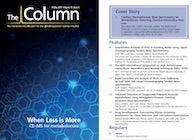Sourcing Prebiotic Oligosaccharides from Vine Shoots
Following decades of research, evidence of the human microbiome’s importance in maintaining overall health and well-being has become evident, spawning a multimillion-dollar industry. A wide range of products aimed at repairing and maintaining a healthy microbiome are now available, with many focusing on prebiotics.
Photo Credit: xjbxjhxm/stock.adobe.com

Following decades of research, evidence of the human microbiome’s importance in maintaining overall health and well-being has become evident, spawning a multimillion-dollar industry. A wide range of products aimed at repairing and maintaining a healthy microbiome are now available, with many focusing on prebiotics.
Described as selectively fermented ingredients that allow specific changes, both in composition and in activity of the gut microbiota, prebiotics pass through the stomach and small bowel intact before reaching the large bowel. They are fermented here by microbiota, such as bifidobacteria and lactobacilli, generating short-chain fatty acids (SCFA). SCFAs are involved in many important physiological events, such as bowel function, calcium absorption, lipid metabolism, or the reduction of colon cancer risk (1).
Most commercialized prebiotics will contain inulin, lactulose, galactooligosaccharides (GOS), and fructooloigosaccharides (FOS) as there is enough scientific evidence to give them credibility, however, there are other food ingredients, such as fructans, galactans, xylooligosaccharides, β-glucans, or arabinoxylands that are gaining attention because of their prebiotic properties.
Xylooligosaccharides, which are formed by xylose units linked through β-1,4 glycosidic bonds, are receiving particular attention because they can be obtained from lignocellulosic residues, such as hardwoods, hulls, brans, corn cobs, and corn stover, or from industrial by-products, such as brewery spent grains and shells (2). The low cost combined with renewability and high availability makes them a promising source of probiotics, however, research on their viability as prebiotics in limited. To address this, researchers investigated the prebiotic activity of oligosaccharides obtained from vine shoots-one of the most abundant byâproducts produced by wineries-with 2–4 tons being produced per hectare per year (3).
The vine shoots were subjected to hydrothermal treatment before purification and prebiotic evaluation using a range of techniques, including high performance liquid chromatography (HPLC), matrix-assisted laser desorption–ionization time-of-flight mass spectrometry (MALDI-TOF), high-performance anion-exchange chromatography with pulsed amperometric detection (HPAEC-PAD), and ultrahigh-performance liquid chromatography–diode array detector-electrospray ionization-mass spectrometry (UHPLC–DAD-ESI-MS).
Results confirmed the suitability of a refined mixture of xylooligosaccharides as a prebiotic ingredient. Structural characterization provided insight into the compound, and a fermentation test using human faeces confirmed the generation of SCFAs, which are the desired product of prebiotics and, which have many positive health benefits.
References
- C.E. Rycroft et al., J. Appl. Microbiol.91, 878–887 (2001).
- P. Gullón et al., J. Agric. Food Chem.87, 257–265 (2008).
- I. Dávila et al., Carbohydr. Polym.207, 34–43 (2019).

Understanding FDA Recommendations for N-Nitrosamine Impurity Levels
April 17th 2025We spoke with Josh Hoerner, general manager of Purisys, which specializes in a small volume custom synthesis and specialized controlled substance manufacturing, to gain his perspective on FDA’s recommendations for acceptable intake limits for N-nitrosamine impurities.
University of Rouen-Normandy Scientists Explore Eco-Friendly Sampling Approach for GC-HRMS
April 17th 2025Root exudates—substances secreted by living plant roots—are challenging to sample, as they are typically extracted using artificial devices and can vary widely in both quantity and composition across plant species.
Determining the Serum Proteomic Profile in Migraine Patients with LC–MS
April 17th 2025Researchers used liquid chromatography–mass spectrometry (LC–MS) in their proteomic analysis to compare the serum proteome of migraine patients with healthy controls and to identify differentially expressed proteins as potential migraine biomarkers.













